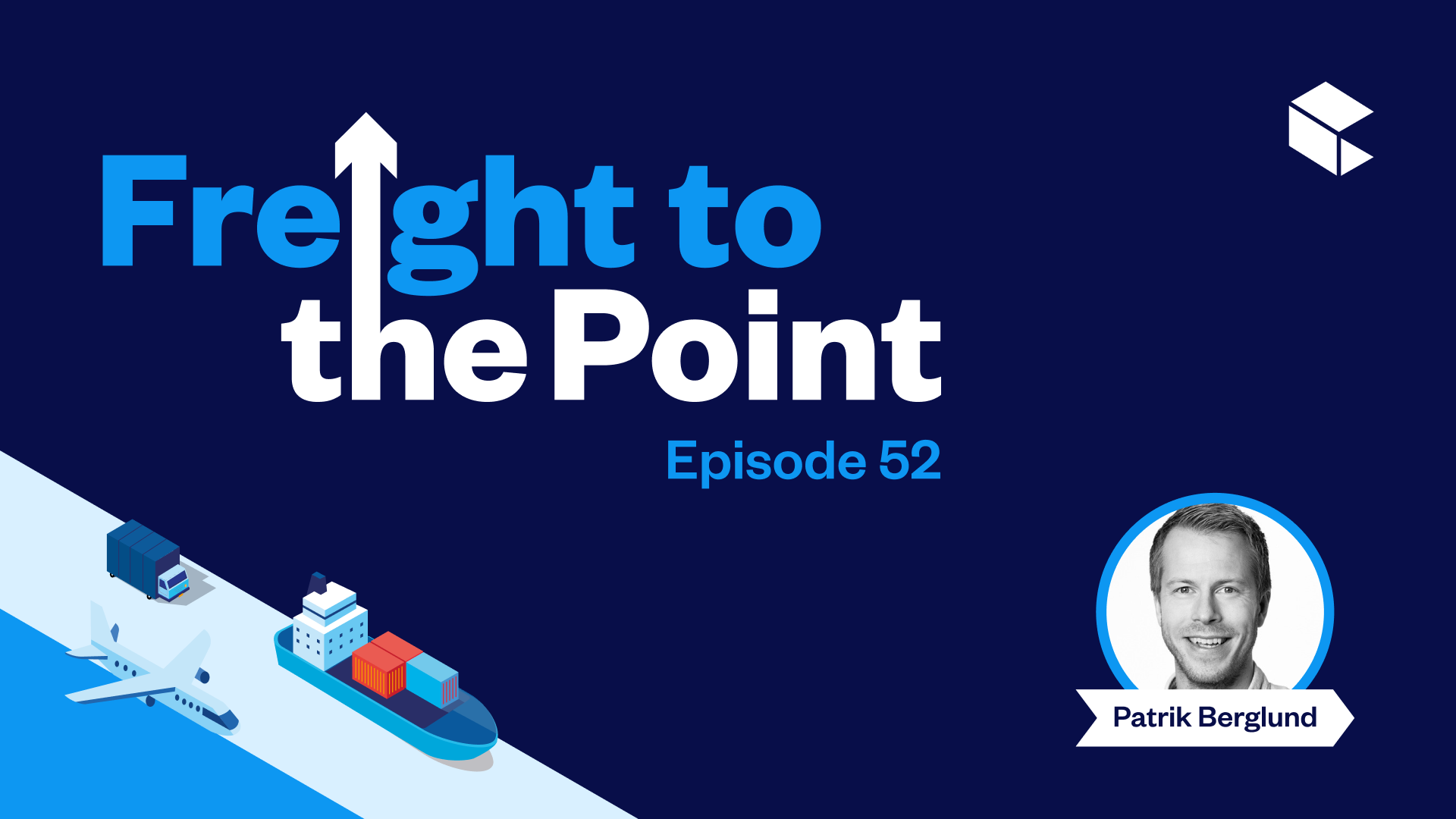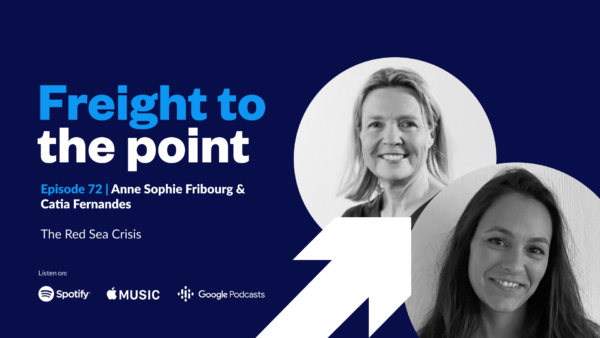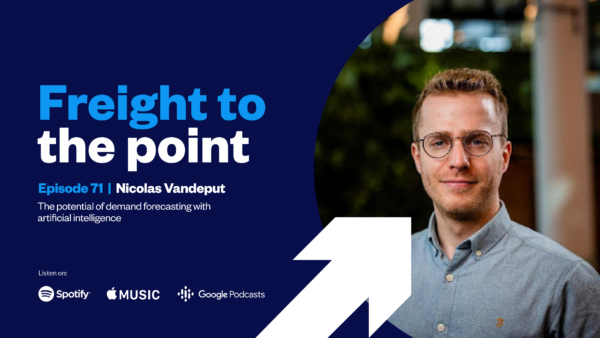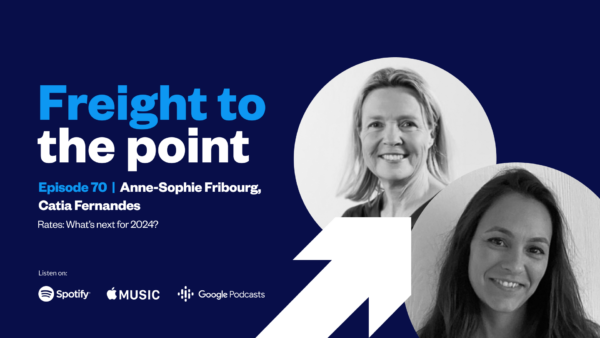Episode 52:
Rates:
Long term vs Short Term
See all episodes

“Now is a good time to engage in the conversation. Rates are at lower historical levels and it’s a good time to be thinking in terms of contracting.”
Long term or short term?
That’s the question we’ve been hearing a lot around the rate market. Rates appear to be bottoming out so is now the time for shippers to finally lock in long term contracts?
That’s what Richard Fattal, CCO and Co-Founder at Zencargo and Patrik Berglund, CEO and Co-Founder at Xeneta talk about in the latest episode of Freight to the Point.
They discuss:
- Rate trends on specific trade lanes
- Whether shippers should be locking in long term rates
- Will demand pick up in the later half of the year?
Patrik Berglund
Patrik Berglund is the CEO and Co-Founder of Oslo-based Xeneta, the leading ocean and air freight rate benchmarking and market analytics platform transforming the shipping and logistics industry with data analytics. Berglund, a logistics and tech-enthusiast, possesses a true passion for modernising business processes related to logistics procurement and the supply chain. He has in-depth logistics and transportation experience from several years at Kuehne + Nagel in various roles and also as Co-Founder of Nordilog, a logistics consultancy firm. Founded in 2012, Berglund has grown Xeneta to be the top worldwide source comparing shipping rates against the market average, market highs and lows, ultimately transforming companies’ logistics procurement with actionable data intelligence. Berglund was the 2016 recipient of the prestigious Lloyd’s List Next Generation in Shipping award.
Resources
Episode 15: Identifying reliable data in the supply chain with Peter Sand
Hello and welcome to another episode of Freight to the Point. I’m Richard Fattal, your host and Zencargo’s co-founder. So, long term or short term? That’s a question we’re hearing a lot at Zencargo and over the past six months, rates have been dropping, but when will they bottom out? When should shippers be locking into those long-term contracts? Particularly now is an interesting time. It’s the key decision point in the transpacific trade. When will rates pick up again and what’s going on with cargo flows? These are questions I’ll be exploring with Patrik Berglund, CEO and co-founder of Xeneta. Welcome Patrik, and thank you so much for coming back on the show.
Patrik Berglund:
Hey Richard, pleasure being here. I think you nailed it perfectly in terms of some of these challenges with the market today, but we’ll get into that.
Richard Fattal:
Awesome. And for those who don’t know what Xeneta is, Xeneta is a tool that Zencargo use and it allows us and many other players in the market to benchmark the global ocean market and the airfreight market as well and help them to understand where rates are and how they’re trending, leveraging a lot of data points that they collect across the market, and we find it a very useful tool.
So let’s talk about the market. Let’s talk about where rates are, their historical context. Of course businesses that have been budgeting and rerunning transportation budgets, especially those where transport is a significant part of cost of goods sold, will have been putting in numbers in December that showed a substantial benefit from transportation as a line item in their costs. This year is a good year for shippers when it comes to realising benefits from transport cost reduction. And I would say since those budgets were set, rates have continued to fall, but can we maybe set this in historical context? How does the market look? And I think it’s a little bit more nuanced than maybe the headlines in terms of rates are at very low levels. Can you give more colour to that, Patrik?
Patrik Berglund:
Yeah, absolutely. I think there’s huge differences from which trades you operate on. Let’s categorise them in sort of a few big front holes outbound from far east into Europe, US, South America, East Coast. Those are some of the biggest trades. They’re all sort of more or less back to pre-COVID levels, but we can see that for South America and for US, some of the GRIs in our data sets now and are, early days, somewhat sticking. So just to give you an example. We’re talking about South America where the rates is about $700 higher than the beginning of March. So that’s a quick substantial increase. Let’s see if it sticks. But this is happening while the long-term market is trending downwards so they’re sort of meeting each other again now, which has been expected. US, West Coast down to 2019/20ish levels, not fully on the contract side, but trending in that direction.
If some of these GRIs, it might seem that we reach some level of bottoming up depending on how much the carriers are able to pull out of the market in terms of capacity, sort of balancing supply and demand. On the back holes, we are seeing some of these trades back to pre-COVID level, but for instance, US, West Coast to far east Maine, which is down, it’s not back to the levels we saw in 2019 fully, but it’s so low levels that I would say most shippers don’t negotiate that hard anymore because they already seen substantial reductions. And then one last cluster of trades, which is transatlantic, right, where if you look Europe, US, East Coast, it’s fallen off a cliff as the main holes that I started talking about, but there’s still almost double of what we saw in 2019, beginning of 2020. So there’s more potential reductions there.
And then on the South America, East Coast to North Europe back and forth, both of those directions are elevated relative to 2019/20 levels. So it’s not fully sort of the whole world is back to pre-COVID levels at all, to be honest. Really depends on where you ship from and to.
Richard Fattal:
Well, I guess we know from our basic economics that in a competitive market, and it seems like we’ve seen, from recent behavior, that the market is somewhat competitive, that prices when there’s a lack of demand can really fall to marginal cost. But when we talk about 2019, 2020, carriers at least say from their side and many market players have run calculations on this, that cost levels have very much changed over the last four or five years. So maybe we should be thinking about 2019, 2018, 2020 levels as not necessarily the baseline to reference. That doesn’t mean that rates can’t go there or go below there for a short period of time, but as I understand it, fuel prices are higher today and there’s different fuel regulations for the carriers. There’s the IMO and of course challenges in terms of inflation and labour prices across the board.
Patrik Berglund:
Yeah, and chartering rates are high, but Richard, I usually point this out that I’ve seen rates from Shanghai to Santos for $50 over the last 10 years and I’ve seen it for $20,000. So none of those price points has anything to do with cost, right? It’s a pure supply and demand balance that drives prices. And I think this is what we’ve been seeing over the last six to nine months as well, that it’s simply been too much capacity of relative to the cargo that has been moved and the reduction of volumes into the US in particular and also into Europe has been more than the carriers anticipated and has come with worse consequences than the carriers foresaw. So this has been a brutal reduction for them and we will see the full effect of this when they report their Q2 and Q3 earnings. And then if they turn it around in that period, then they can have maybe a healthy financial Q4 at best.
But this is going to be a struggle for them because as you said, their cost base is increased and now rates have fallen off on some of these big volume trades significantly, and they will be looking to deploy more capacity into some of these trades that are still holding up, which is creating downward pressure on those as well.
Richard Fattal:
We’re talking about carrier behavior. I think we’ve seen since the start of the year, the carriers took some lessons from the beginning of the COVID period where they really learned that taking capacity out of the market can have an impact on the rates. And I think they dipped their toe in at the beginning of the year. They maybe didn’t react fully in line with the rate of the reduction in demand, but now we’ve seen the last month or two very, very significant reductions in capacity and that, a lot of people are speculating, is behind the current ability to try to implement a GRI, et cetera. To what extent do you think this is kind of like an opportune time? Because obviously on the TP trade there’s the negotiations, et cetera, so it’s very important to kind of take capacity out now or do you think capacity will come back in?
Patrik Berglund:
I think for both of these main contract sort of periods going through the first half of this year with European importers and exporters and US based ones, I think it’s already too late, to be honest. They won’t see new contracts signed at elevated levels for the first half of this year. We can already see that in the data sets, right, and we already see tender rounds coming in as we follow through one or two or three bidding rounds as well, and that is too late. What I think is different now is that when COVID hit, their wallets and pockets were empty. They had hardly made any profits for six-ish years. And I know there’s some cyclicality to that, so don’t get me wrong, but overall there wasn’t a lot of profitability and now they’re trying to adjust things but from a financially sort of sound position, so that has made them a little bit, I believe, slower and they haven’t seen the urgency as they did when COVID hit, and that’s why they’re too late now to have any meaningful impact for 2023.
That doesn’t mean that they can’t move things around in, as I said, Q3 and Q4, to jack up the spot market, but for now there’s too little cargo, too much capacity still, and what would really benefit the carriers if there’s a sort of restocking event over the next four-ish months within almost like an artificial increase where they have pulled that capacity again, that’s what really might change the equilibrium enough for these initial first GRIs that we’ve just seen for them to stick properly.
Richard Fattal:
Well, it’s funny that you talked about them being cautious and being in a better position financially. I think sometimes we talk about the market like it’s a real commodity and there is an extent to which it’s like a commodity, but obviously carriers have direct contracts and relationships with end clients, and there is a service dimension to this. When carriers think about taking out capacity in order to react to changes in demand, in order to stabilise the market and also ensure that they’re not running empty, that reduces the service frequency, it reduces the reliability, and to the extent that customers are loyal to any one carrier, it means that they might go elsewhere. So making a very quick decision can always be a challenge. And it looks like for the rest of the year, for the next 18 to 24 months, we’re going to be going through a period where capacity’s coming in and out of the market and therefore instability is something that people need to be, I guess, ready for in terms of service levels.
With the market now looking like it might be bottoming out and with the potential introduction of GRIs, how do you see contracting in the market? How do you see, let’s say on the main hole lanes in particular, Asia/Europe, Asia/USA, how should people be thinking about contracting a part of their business?
Patrik Berglund:
Yeah, I think that depends a lot to sort of how sensitive you are to this cost element in terms of the profitability of your business. So if you’re a low value, low margin commodity, then you are more sensitive to getting the absolute cheapest rates that you can get your hands on in the market. And on these front holes, I would say it’s a little bit of a gamble to strike the long-term deals as it’s been in the past, the 12-month period. So for those, I would say there’s like two options. Either go maybe six month validity or choose an index provider that ensures that you’re staying in line with the market and make sure you have some level of commitment from the carrier or the forwarder you’re working with to perform relative to that in index. And then if you’re a slightly different business, you’re not that sensitive or exposed to sort of movements of 2, 3, 500, 600 US dollars, then I would say it’s a really good time to lock in a long term deal.
Richard Fattal:
I would very much agree with that because if you’re locking in a long term deal now, in most cases you’ll be paying a small premium to the lowest levels that we’ve currently seen in the spot market. They’re not trading at significant discounts and therefore if you’re in the commodity market, you are paying up versus your competitors who are on spot who are not getting an advantage, and it means for the short term, there’s more risk in doing that potentially. Whereas if you’ve got stable flows and some cargo which has less seasonality, consistent flows throughout the course of the year, and you can sustain current levels within your margin by contracting at this point, you’re really at a relatively low cost of transportation and you ensure a certain level of service. So long as you are accepting a within market rate, you’re not accepting, let’s say, a teaser rate or a rate which is artificially low, you should be supported by the carriers.
And of course there are kind of tools like Xeneta or your freight provider can guide you on that in terms of what’s a reasonable level in order to make sure your cargo clears over the longer term. I think that’s the way I would look at it. The one thing I would say beyond just let’s say cost of goods sold or transport component in terms of the way of thinking about it is we like to stratify our customers a little bit in terms of their seasonality and that might mean that we suggest some amount of cargo which is on the spot market and some amount of cargo which is contracted, allowing them to have a little bit of flexibility in terms of volumes.
Patrik Berglund:
Yes. And you can obviously also choose different, in order to hedge your bets a little bit depending on how much volume you have obviously, you can also choose some part of the volume to go on a 12 month and some part of the volume to go on a six month. So there are numerous in between scenarios here that they can pick and choose to hedge their bets a bit.
Richard Fattal:
I think the point is though, now is a good time to engage in the conversation. Rates are at lower historical levels and it’s a good time to be thinking whether the benefits you’ve benefited from in terms of being spot should now be locked in in terms of contracting.
Patrik Berglund:
Although I would say that it’s still trade specific. So how I would think about transatlantic North, South moves versus these big front hole trades would be very different. Yeah.
Richard Fattal:
Yeah, 100%. And I guess one more thing to touch on, and it’s the big kind of elephant in the room and you raised it, which is, when is the demand coming back? And it’s funny, it’s tough to draw trends at the moment. We do see positive data out of China. I think we’re encouraged by the latest economic data. We’re also seeing inflation levels a little bit lower. So some of the monetary policy that we’re seeing globally starting to bite, starting to have an impact and that natural stabiliser coming through the economy and that seems positive. That’s many of the conversations that we’re having and the order flow that we’re seeing. We’re still seeing businesses in a destocking trend and the order books look like they’re not really picking up until Q3. I don’t know how you are seeing it in your customer conversation. So what’s your thinking then?
Patrik Berglund:
So in our latest customer webinar, we asked this question and we had more than 100 companies participating, and keep in mind we work with quite significant volume players. Only 25% of them reported that they see no volume reductions for 2023. Everybody else, 75%, reported either a decrease, but it’s from one to 50%, and 20% is reporting one to 10%, everybody else north of that. So we have a rather pessimistic view on what we can see over the next, I would say, at least quarter. I would love to see some sort of positive curveballs. It’s too much maybe to hope for sort of Russia/Ukraine war to come to an end in that sort of timeline. But either the carriers needs to be really sharpening their knives and cutting capacity in order to meet the volume reductions we’re seeing and hearing, or we need some curveball event like the Ukraine/Russia to create more positivity, to create some change over the next, I would say, one to two quarters.
Richard Fattal:
Yeah. And a lot of people are talking about Russia/Ukraine as being a real accelerant, because not only will it give a lot of confidence to the global economy and mean that order books pick up, but it will also, specifically in Russia/Ukraine where the ships haven’t been going and where there’s been for your cargo flows, mean that generally after a war, there’s a boom and there’s a period of reconstruction and so there’ll be demand on top of the kind of global flip that we would see. We would see localised demand as well. But of course no one can predict what’s happening now. We can only hope for a kind of swift resolution of the situation. And in the meantime, everyone’s kind of watching the numbers at the tills and trying to see when the pickup is going to be. But at least what we’re seeing from the macro data is no significant continued deterioration of the economy.
Patrik Berglund:
Agreed. Agreed.
Richard Fattal:
Okay. So on that, I guess we’ve explored the freight market and I would say I conclude from what you are saying, Patrik, that now is a good time to engage on kind of freight market strategy to think about whether markets are bottomed out. Again, it’s trade specific and it’s nuanced and it really depends on your business strategy and the peculiarities of your business flows. But do reach out to the partners that you work with and start to have that conversation because the market looks very different to how it looked three months ago and six months ago, and timing is good. I’d love to have this conversation again, Patrik, in a few months time when we’ve seen how it’s played out.
Patrik Berglund:
Absolutely. Looking forward to that, Richard.
Richard Fattal:
Thank you so much for joining us for another episode of Freight to the Point, and don’t forget to like and subscribe to our series on Spotify, Apple Podcast and Google Podcasts. And if you enjoyed this episode, please tune in again.

Episode 72: The Red Sea Crisis
In the latest episode of Freight to the Point, we’ve featured our most rec...

Episode 71: The potential of demand forecasting with artificial intelligence
In the most recent instalment of Freight to the Point, Lucie Phillips, Zen...

Episode 70: Rates: What's next for 2024?
As we prepare for the year ahead, it's crucial to consider the three pillars...

